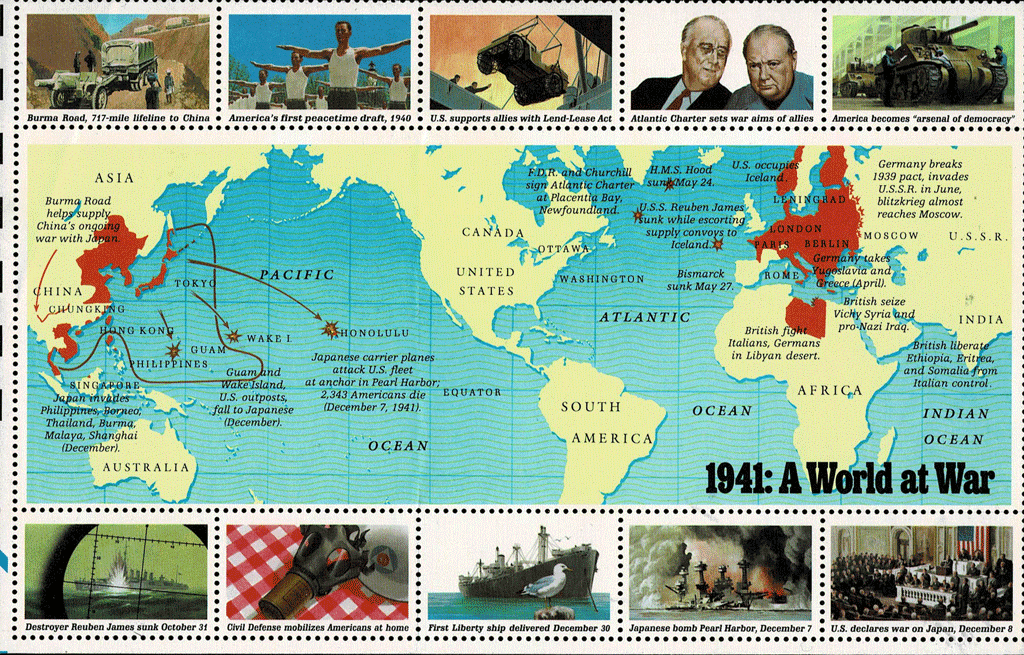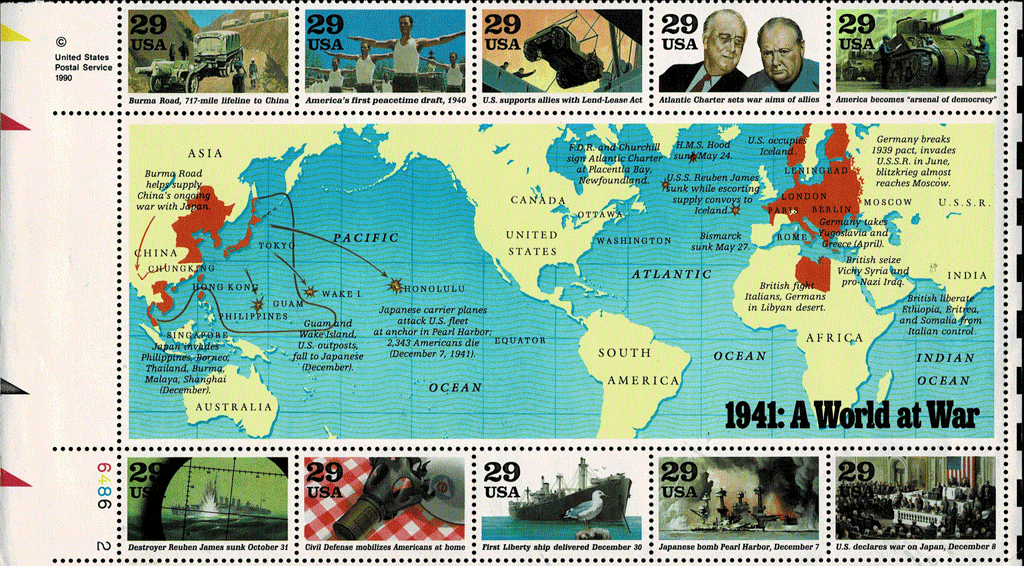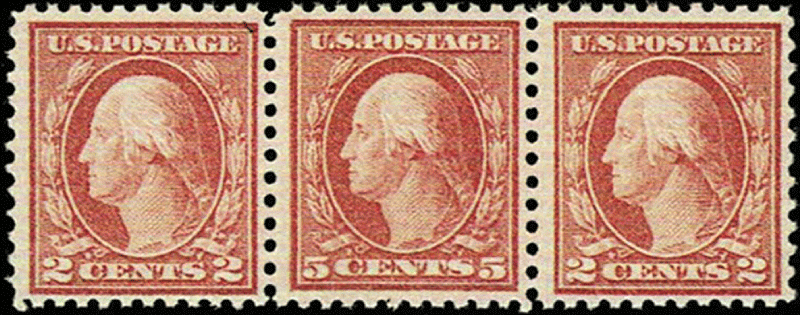Seeing is believing
by John M. Hotchner
One of my favorite U.S. issues was the creative World at War series of five sheetlets released over five years from 1991-1995, in recognition of the 50th anniversary of World War II. An example of the 1941 sheet (Sc. 2559) is shown here. 
Combining ten images per sheet with a map showing where 1941’s most important events took place was pure genius. And the people who made the series happen were Jack Williams, the Postal Service project manager, Howard Paine, the Art Director and typographer, and William Bond, the designer.
 Take a look at the 1941 sheet. Do you notice anything wrong? I’m reading a book now titled Thinking, Fast and Slow, by Daniel Kahneman. One of the many points it makes in discussing how our brains work is that our default is to see what we expect to see. I asked twelve stamp collector friends what was wrong with the sheet shown here. None identified the problem. Several studied the sheet for over a minute.
Take a look at the 1941 sheet. Do you notice anything wrong? I’m reading a book now titled Thinking, Fast and Slow, by Daniel Kahneman. One of the many points it makes in discussing how our brains work is that our default is to see what we expect to see. I asked twelve stamp collector friends what was wrong with the sheet shown here. None identified the problem. Several studied the sheet for over a minute.
This is not a criticism of them. None were error specialists and they are not oriented toward looking for errors, or what might be wrong with a stamp. If you have identified the fact that there is no intaglio inscription saying “29 USA” on each stamp, you get a gold star. Compare this sheet with the normal one below and the error will become obvious. Once you know what to look for it is instantaneously to see in the fourth stamp in the top row; the one with FDR and Winston Churchill.
Only two of these sheets are reported. It seems only one pane with two sheets escaped the printing operation and were sold. It likely happened when two panes together, instead of one, went through the press adding the engraving. The one underneath did not get the engraved image.
The current Scott Specialized Catalogue values the error at $6500. Had you been the lucky buyer, would you have noticed the error?
This is my point. Some varieties are obvious: stamps you can’t tear apart to use (imperfs), misperfs with a split design, inverted airplanes, even some missing colors. But unless you have trained yourself to look for the more subtle varieties, you may use a stamp worth hundreds or thousands of dollars on your electric bill!
How to train yourself? First and foremost, pay attention. Know what the normal stamp should look like and if you see anything you are not certain about, compare it with the normal. It also helps to know what exists. For example, the 1917 perf 11 flat plate carmine 2¢ George Washington, see the strip nearby, exists with the denomination “5” instead of “2”, as you will note on the middle stamp. This error is found on one or two stamps in some sheets of 100 of the perf. 10 (Scottt #467) and perf. 11 printings (Scott #505).  You can go through tens of thousands of these cheap stamps and not find one, but if you do, you will be well rewarded as the catalogue value for a used single is $600.
You can go through tens of thousands of these cheap stamps and not find one, but if you do, you will be well rewarded as the catalogue value for a used single is $600.
A good way to orient yourself to errors and other varieties is to join the Errors, Freaks & Oddities Collectors’ Club. Information is below, or on its website.
Should you wish to comment on this editorial, or have questions or ideas you would like to have explored in a future column, please write to John Hotchner, VSC Contributor, P.O. Box 1125, Falls Church, VA 22041-0125, or email, putting “VSC” in the subject line.
Or comment right here, below.
The EFOCC was founded in 1986 in recognition of the fact that collecting printing varieties had become its own specialty, not just adding odd stamps to a normal collection. The international membership is made up of collectors who seek EFOs to make their country album more interesting, and collectors who enjoy studying production methods and the philatelic material that results when it doesn’t work properly.
EFOCC has a 28-page full-color quarterly, The EFO Collector, with feature articles, new discoveries, member information, free member ads, club activities, and an EFO auction in each issue. The EFOC and the broad and deep website, www.efocc.org, are managed by club Vice President Cemil Betanov, from New Hyde Park, NY.
Membership is $20 a year in the U.S. An application form is on the Society website.




Good day. My name is Zdenek Prkno. I live and work in Germany and in my free time I collect stamps. Now I have a special and very valuable stamp with a watermark upside down. This variant is not mentioned at all in the Michel catalog or in the Scott catalog. It is therefore a rarity among stamps and the price of such an exceptional stamp is certainly very high. It is a US stamp from 1901, 2c, Mi 133 with Wz1x, or Sc 295 with Wmk191. However, the watermark is upside down. please advise what is the approximate value of such a mark and where can I safely provide attestation + valuation and sale at auction ?? And also where can I report this special finding? Please advise me on how to proceed. Thank you in advance and have a nice day. Zdenek Prkno.
I recommend you contact Ken Martin, Director of Expertising (stamp certification or “attestation”) at the American Philatelic Society: kpmartin@stamps.org Such a stamp as you describe is far outside my area of expertise, but Ken can put you on the right track. Good luck.